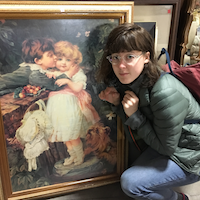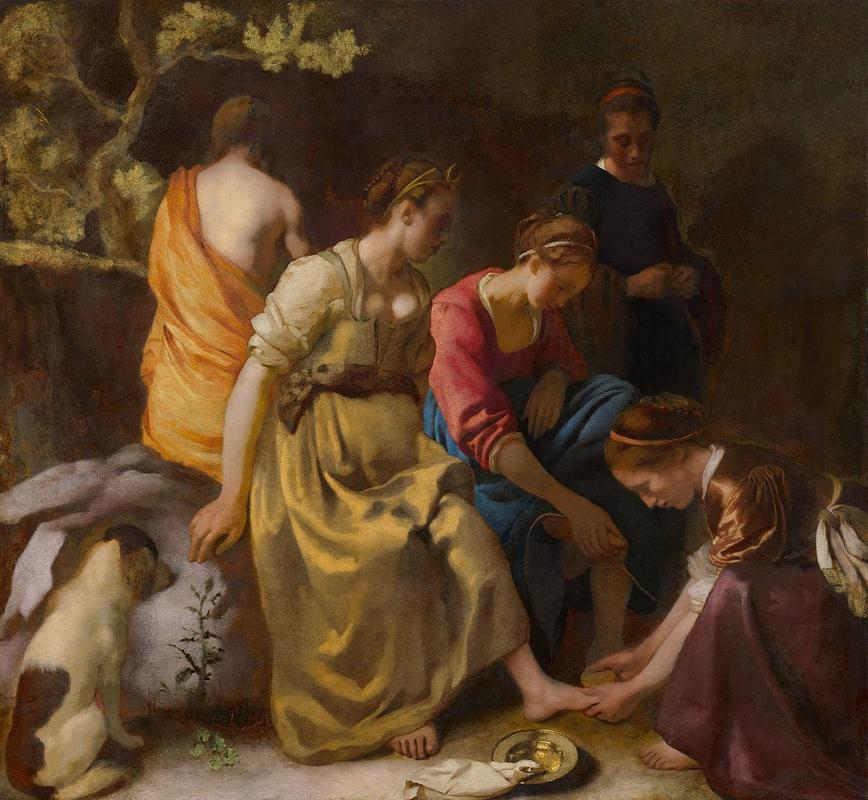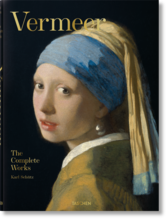More about Diana and Her Nymphs
- All
- Info
- Shop

Contributor
“This will be worth millions someday,” said no one ever about a Johannes Vermeer painting.
Sometimes collectors or museums will safeguard the artwork of little-known artists in hope that they will become famous one day. This was not the case with Johannes Vermeer. Diana and Her Nymphs wasn’t revealed to be a verifiable Vermeer until two centuries after his death. Vermeer’s Diana garnered a pretty penny when it was sold to the Mauritshius from a private collector in 1876, under the name of Nicolaes Maes—a well-known artist replete with the street cred that comes from being a student of Rembrandt. A restoration revealed the real signature underneath, but it was subsequently thought to belong to Vermeer of Utrecht (not to be confused with our leading man, Vermeer of Delft). Needless to say, the original author was neither Maes nor Vermeer of Utrecht.
It would be easy to write this off as an innocuous case of misattribution, if the painting hadn’t been, say, signed by Vermeer with his trademark autograph, I.V. MEER. But it was. Someone took it upon themselves to utilize that foolproof trick that we all depend on to fix any grave spelling mistakes written in pen: adding a curve on an “I” to make a “J,” for instance. With a few swift strokes, the signature displayed in the bottom corner of Diana and Her Nymphs went from that of Vermeer to something resembling that of Nicholaes Maes, and that’s how it remained until the 20th century when historians finally convinced themselves of its true origins.
Paintings of mythological nature usually endeavor to depict multiple scenes on the same theme, however true to his style, Vermeer took it down a notch to display a mere glimpse into an elaborate story arch. The myth, from Ovid's Metamorphosis, follows the Roman Goddess Diana (Greek Artemis) and her attendants as they decide to spontaneously bathe in the woods one day while out hunting. They're discovered by the young prince Actaeon, who catches a lustful glimpse of Diana's nude body. The enraged Goddess turns Actaeon into a stag who is then torn to shreds by his own hounds. It's almost hard to believe that a female revenge story could become popular in a mega-patriarchal society, but I'm not going to argue—it's a satisfaction that I can't resist.
Painted between 1653 and 1656, at the ripe age of twenty-one, Diana is Vermeer’s earliest known work and a far cry from the bright and ethereal compositions of such works as The Milkmaid and The Guitar Player. I'd venture to guess that this was during a period of experimentation before he figured out exactly what his preferred style would entail. I mean, I don't know what you were drawing when you were twenty-one, but my seminal works more closely resembled stick figures and flowers. Although Vermeer opted to leave out the bit about Actaeon discovering the bathers, instead focusing on the emotions of the female characters, he couldn't let it go without at least one nod to male superiority. The cute pup peeping in from the side, Diana's hunting dog, likely represents; 1) fidelity, perhaps in reference to his recent marriage to Catharina Bolnes or 2) the looming male presence that presides over the myth. In fact, in this case, even the viewer doubles as a stand-in for Actaeon. I can't say I'm surprised; a female-centered 17th century artwork without a side of creepy male gaze is as rare as a needle in a haystack.
Sources
- Jonathan Janson. "Diana and her Companions." EssentialVermeer. http://www.essentialvermeer.com/catalogue/diana_and_her_companions.html…. (accessed February 20, 2018).
- Liedtke, Walter, Michiel Plomp, and Axel Rüger, Vermeer and the Delft School (New York: Metropolitan Museum of Art, 2013), 360-363
- Binstock, Benjamin. Vermeer's Family Secrets: Genius, Discovery, and the Unknown Apprentice (New York: Routledge, 2009), 66-68
Featured Content
Here is what Wikipedia says about Diana and Her Companions
Diana and Her Companions (Dutch: Diana en haar Nimfen or Diana en haar gezellinnen) is a painting by Dutch artist Johannes Vermeer completed in the early to mid-1650s, now at the Mauritshuis museum in The Hague. Although the exact year is unknown, the work may be the earliest painting of the artist still extant, with some art historians placing it before Christ in the House of Martha and Mary and some after.
The painting's solemn mood is unusual for a scene depicting the goddess Diana, and the nymph washing the central figure's feet has captured the attention of critics and historians, both for her activity and contemporary clothing. Rather than directly illustrating one of the dramatic moments in well-known episodes from myths about Diana, the scene shows a woman and her attendants quietly at her toilette. The theme of a woman in a private, reflective moment would grow stronger in Vermeer's paintings as his career progressed.
Nothing of the work's history before the mid-19th century is known, and the painting was not widely accepted as one of Vermeer's until the early 20th century, when its similarities with Mary and Martha were noticed. About one ninth of the painting's width has been removed from the right side, and it was not discovered until 1999 or 2000 was that the sky in the upper right-hand corner had been added in the 19th century.
Check out the full Wikipedia article about Diana and Her Companions














